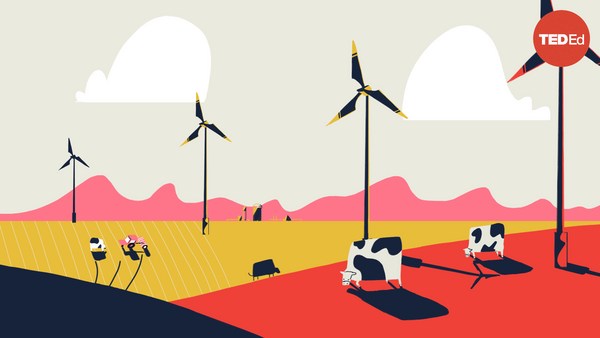As of 2020, the world’s biggest lithium-ion battery is hooked up to the Southern California power grid and can provide 250 million watts of power, or enough to power about 250,000 homes. But it’s actually not the biggest battery in the world: these lakes are.
Wait— how can a pair of lakes be a battery? To answer that question, it helps to define a battery: it’s simply something that stores energy and releases it on demand. The lithium-ion batteries that power our phones, laptops, and cars are just one type. They store energy in lithium ions. To release the energy, the ions are separated from their electrons, then rejoined at the other end of the battery as a new molecule with lower energy.
How do the two lakes store and release energy? First, one is 300 meters higher than the other. Electricity powers pumps that move billions of liters of water from the lower lake to the higher one. This stores the energy by giving the water extra gravitational potential energy. Then, when there’s high demand for electricity, valves open, releasing the stored energy by letting water flow downhill to power 6 giant turbines that can generate 3 billion watts of power for 10 hours.
We’re going to need more and more giant batteries. That’s because right now, generating enough electricity to power the world produces an unsustainable amount of greenhouse gas: 14 billion tons per year. We’ll need to get that number down to net-zero. But many clean energy sources can’t produce electricity 24/7. So to make the switch, we need a way to store the electricity until it's needed. That means we need grid-scale batteries: batteries big enough to power multiple cities.
Unfortunately, neither of the giant batteries we’ve talked about so far can solve this problem. The two lakes setup requires specific geography, takes up a lot of land, and has high upfront costs to build. The giant lithium-ion battery in California, meanwhile, can power about 250,000 homes, yes, but only for an hour. Lithium-ion batteries are great for things that don’t use a lot of power. But to store a lot of energy, they have to be huge and heavy. That’s why electric planes aren’t a thing: the best electric plane can only carry two people for about 1,000 kilometers on one charge, or its batteries would be too heavy to fly. A typical commercial jet can carry 300 people over 14,000 km before refueling. Lithium-ion batteries also require certain heavy metals to make. These resources are limited, and mining them often causes environmental damage.
Inventors all over the world are rising to the challenge of making batteries that can meet our needs— many of them even weirder than the two lakes.
One company is building a skyscraper battery. When the sun is shining, a crane powered by solar energy piles blocks on top of each other in a tower. At night, the cranes let gravity pull the blocks down and use the resulting power to spin generators.
Though there have been some early setbacks, another promising approach involves heating up salts until they melt. The molten salt can be stored until there’s a high demand for electricity, then used to boil water. The steam can power turbines that generate electricity.
Another idea: bio-batteries made from paper, powered by bacteria, and activated by spit. Bacteria release energy in the form of electrons when they metabolize glucose, and at least one species of bacteria can transfer those electrons outside its cells, completing a circuit. While these batteries won’t power a city, or even a house, they don't have the waste and cost concerns of traditional batteries.
From vast mountain lakes to microscopic bacteria, from seawater batteries that bypass the need for heavy metals to nuclear batteries that power deep space missions, we're constantly rethinking what a battery can be. The next unlikely battery could be hiding in plain sight— just waiting to be discovered and help us achieve a sustainable future.


